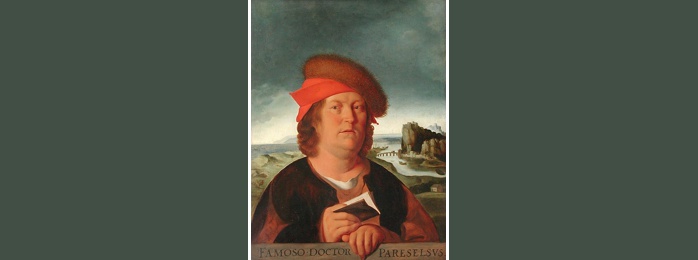
Press the audio play button for a deep dive on Paracelsus, Physician and Philosopher
Theophrastus Phillippus Aureolus Bombastus von Hohenheim, better known as Paracelsus, was born in Einsiedeln, Switzerland in November 1493 and died in Salzburg on September 24, 1541. He was a medical doctor, alchemist and philosopher who provoked controversy during his lifetime and still invokes controversy today when his name is mentioned.
The question his reputation invites is whether he was a man of the Middle Ages or of modern times. If you examine his writings in the context of the Renaissance period, you will find an individual who was well ahead of the thinking of his day.
Paracelsus believed that a human being has two bodies; a visible body that belongs to the earth, and an invisible body of heaven. The invisible one is closely attuned to imagination and the spiritual aspect of the individual. Paracelsus understood well the psychosomatic abilities of people, as he stressed the importance of suggestion, using signs and amulets to help a patient form mental images, which translated into profound physical cures.
Alfred Edward Waite mentions in his book, Hermetic and Alchemical Writings of Paracelsus (1894), “History tells us that Paracelsus was a difficult man, prone to outbursts of invective [Ed: abusive] language aimed at the established medical and spiritual authorities of his time. He abhorred untested theory; during his brief and ill-fated position as Professor at Basel, he invited to his lectures barber-surgeons, alchemists, apothecaries, and others lacking academic background as an expression of his belief that only those who actively practiced an art, knew it. ‘The patients are your textbook, the sickbed is your study.’ He ridiculed those who placed more importance on titles than practice, and solemnly declared that ‘if disease put us to the test, all our splendor, title, ring, and name will be as much help as a horse’s tail.’
He was the first ever to lecture in the language of the street rather than in the official academician’s Latin, and the first to publicly condemn the medical authority of Avicenna and Galen, flinging their writings into a bonfire on St. John’s Day in 1527.”
His medical works dealt with syphilis and its therapy, illnesses like miners’ disease, surgery, and the treatment of wounds. He wrote about medicinal springs (balencology) which were in Switzerland, Austria and southern Germany. His theoretical ideas about the effects of bathing are, in part, very modern.
He always tried to rely on experience, experiments, observations of nature, and reason. “The way to investigate nature is to travel her books with your feet.”
Also, Waite points out, “The conviction of his own experience and practice eventually paid off; he invented chemical urinalysis, chemical therapy, and suggested a biochemical theory of digestion. He demanded that the application of cow dung, feathers and other obnoxious concoctions to wounds be given up in favor of keeping the wounds clean, stating, ‘If you prevent infection, Nature will heal the wound all by herself.’ Thus he anticipated modern techniques of antiseptis by several centuries.”
“In a treatise on syphilis containing the most comprehensive clinical description the period ever produced, we find that he was the first to perceive that the disease could only be contracted by contact. He was the discoverer of the mercury treatment for the disease, as well. The Germ theory was anticipated by him in his proposal that diseases were entities in themselves, rather than states of being. He gave birth to clinical diagnosis and the administration of highly specific medicines, rather than the traditional cure-all remedies of the time. He called for the humane treatment of the mentally ill (but was ignored for several centuries), seeing in them not creatures possessed by evil spirits, but ‘brothers’ ensnared in a treatable malady.”
“He introduced the black hellebore to European pharmacology, prescribing the correct dosage necessary to alleviate certain forms of arteriosclerosis, and recommended the use of iron for ‘poor blood,’ emphasizing the importance of employing only the product of metals and not plants. We can also credt Paracelsus with the creation of the terms, ‘chemistry,’ ‘gas,’ and ‘alcohol’ as well as the discovery of zinc as the active ingredient in the production of brass.”
Manly P. Hall, in his book The Mystical and Medical Philosophy of Paracelsus, writes, “It will be obvious why Paracelsus has become the central figure in a heated controversy involving both the theory and practice of the healing arts. Historians applauding his progress and originality, at the same time bewail his mystical speculations and his excursions into the fields of animal magnetism and electromagnetic therapy. He has come to be regarded as a most complex man, combining a high degree of skilled observation with a variety of superstitious beliefs… it is obvious that Paracelsus was aware of the impending struggle between medicine and magic. To him, the advancement of practical therapy depended upon a continuous exploration of the invisible side of nature — a search for causes — and the realization that man was not simply a physical creature, but a living soul whose internal attitudes could profoundly affect his health.”
The findings of Paracelsus included his discovery of hydrogen and nitrogen. As Manly Hall mentions, “He established a correlation between cretinism and endemic goiter… The German philosopher Lessings states, ‘Those who imagine that the medicine of Paracelsus is a system of superstitions which we have fortunately outgrown, will, if they once learn to know its principles, be surprised to find that it is based on a superior kind of knowledge which we have not yet attained, but into which we may hope to grow.'”
Paracelsus states, “A man who is angry is not only angry in his head or in his fist, but all over… all the organs of the body, and the body itself, are only form-manifestations of previously and universally existing mental states.”
“I am a rough man born in a rough country; I have been brought up in the pine-woods, and I may have inherited some knots. That which seems to me polite and amiable may appear unpolished to another, and what seems silk in my eyes may be but homespun to you.”
